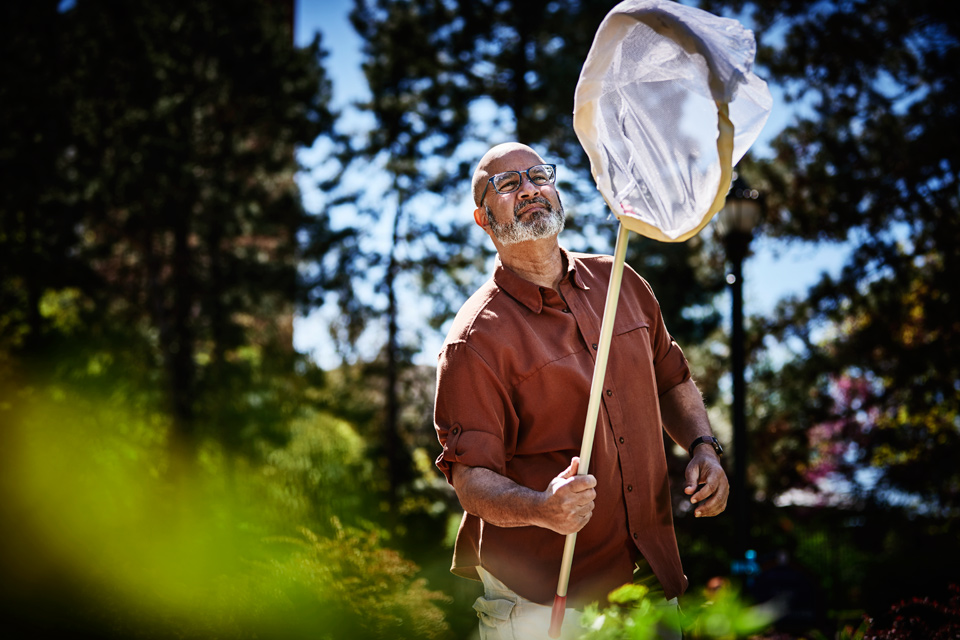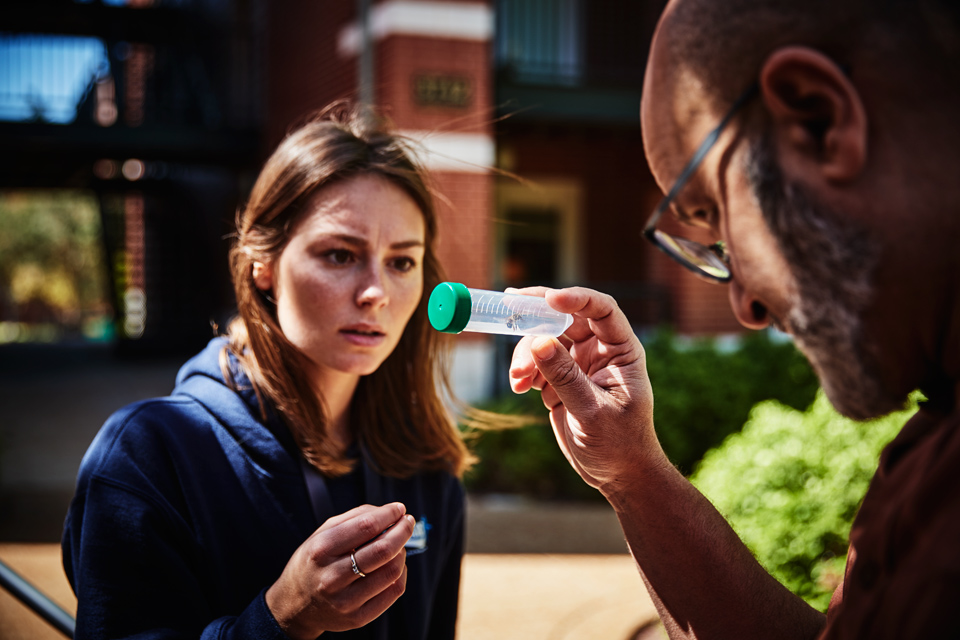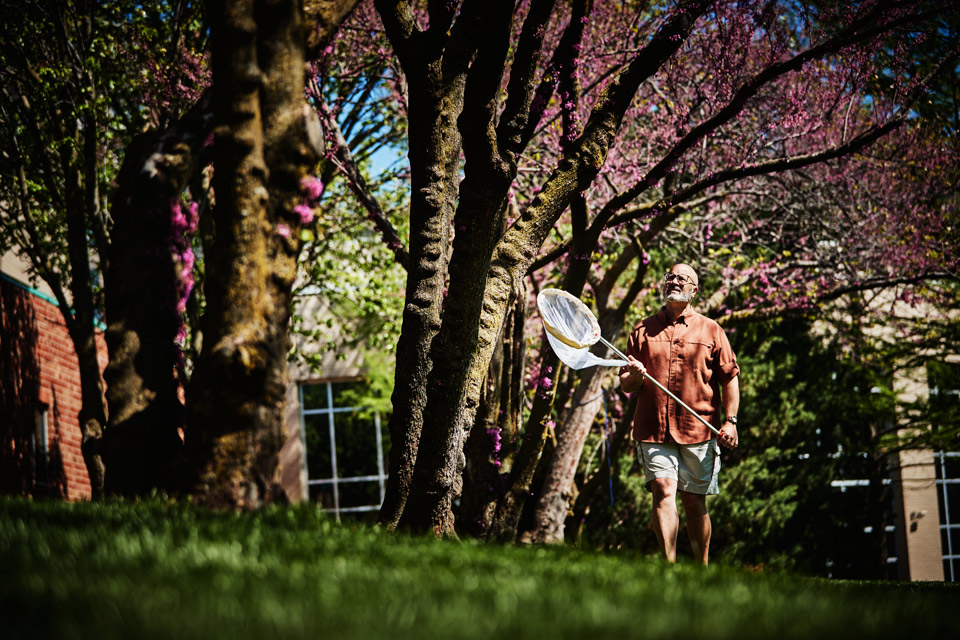Buzz Worthy
Bees are finding refuge in urban areas — including St. Louis — and it’s good news for us all. Dr. Gerardo Camilo and his students head into the field to collect bees and study their relationship with humans.
In the collection room in the basement of the newly renovated Macelwane Hall, Dr. Gerardo Camilo has access to drawers upon drawers of bee specimens, about 18,000 in all. But that doesn’t stop him from searching for more.
The first time he went to collect at Saint Louis University’s community garden years ago, he came across a couple of bees that weren’t on the city’s official species list, so he added them. The next week, he added a few more.
“By the middle of the summer, the city’s list had gone from 37 species to 54. From one community garden. I thought, this is ridiculous,” Camilo said.
He didn’t stop there. Bolstered by research grants, his team expanded sampling to other community gardens across the city over several years. The bee species count for St. Louis is now close to 200. And his work, confirming that native bees are thriving in urban areas, might be key to ending the pollinator crisis.
Pollinator Crusader
A professor of biology in the College of Arts and Sciences, Camilo has somewhat reluctantly become a pollinator crusader.
His work in the community gardens of St. Louis took off right around the time the world was learning of a bee catastrophe, colony collapse disorder, in which honeybee populations were mysteriously vanishing. It made big news, especially because the species pollinates food that people everywhere rely on.
But while media coverage focused attention largely on honeybees, Camilo knew that they aren’t the only ones that count; there are around 20,000 species of bees, and they pollinate about a third of the crops humans use for food, beverages and more. And unfortunately, colony collapse disorder wasn’t the only peril bees faced. Pesticide use, industrial agriculture, even climate change — all of these threaten bees and other pollinators. Communicating this information has become a major focus of Camilo’s work, right up there with collecting bees.
“I didn’t get into ecology or conservation to save anything,” he said. “I do what I do because I like nature and I like insects, and it kills me that we’re in the pickle we’re in. It breaks my heart.”
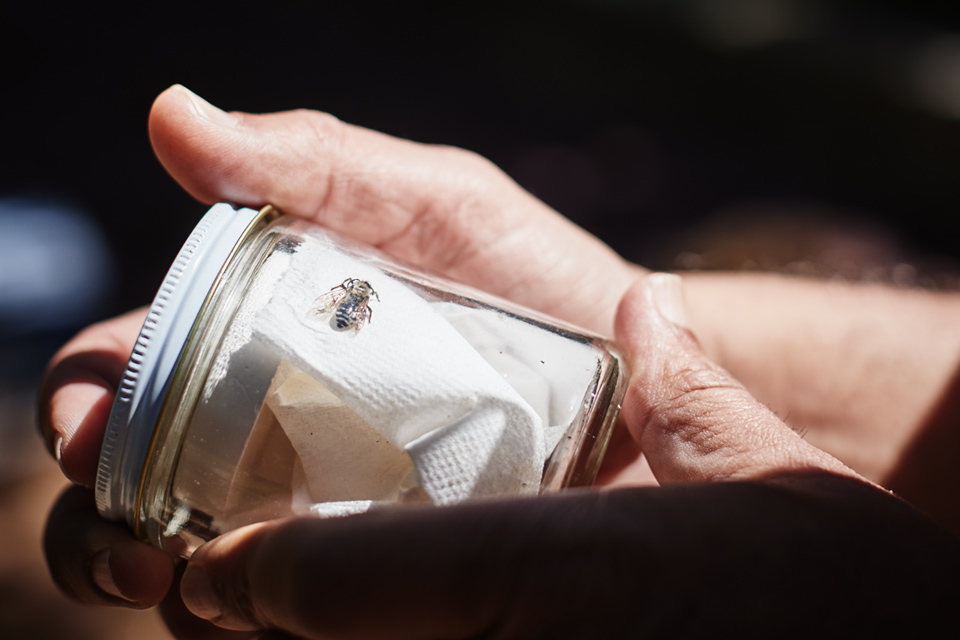
Bug Chaser
Camilo has always been big into bugs.
“As a little kid growing up in Puerto Rico, I chased every bug, every little critter, lizards, frogs,” he said. “My mom hoped I’d outgrow the bug phase. I never did.”
From the start, he found a way to turn his love into his livelihood.
“An American lady lived down the street from us. One day she came screaming out of her house: There was a lizard inside! Now, it’s a tropical environment — we have lizards everywhere. I went in with a friend and caught the lizard. She gave us $5. Mind you, this is 1973 or ’74. We proceeded to collect lizards everywhere and toss them in her yard,” he said, grinning.
He went to college thinking he’d study marine sciences and happened to take an entomology course only because it fit into his schedule.
“After a couple of weeks… marine sciences, what’s that?” he said.
He started chasing bugs again.
His first paycheck as an entomologist was for taking care of honeybees. After that, he widened his scope to social insects: ants, termites and more. He even discovered a species of walking stick insects while working in Puerto Rico.
After getting his Ph.D. from Texas Tech University, Camilo looked for an academic position in the United States. A friend from graduate school was on faculty at Washington University, which meant that St. Louis was on his radar.
I don’t think the kind of research I do would have been as successful if I weren’t at a Jesuit institution.”
Gerardo Camilo
“From the moment I arrived here, it’s been a great place to be,” Camilo said. “Right away, I started collaborating with the Saint Louis Zoo, and I’m now a conservation fellow there. I also have good working relationships with the Missouri Department of Conservation, the Missouri Botanical Garden and the other universities in town. My time at Saint Louis University has been extremely productive.”
Camilo believes his success might have had something to do with SLU’s Jesuit tradition.
“I don’t think the kind of research I do would have been as successful if I weren’t at a Jesuit institution,” he said. “Jesuits are awesome because they’re true believers of taking your scholarly research down the path that it dictates, not the other way around.”
Hive Mentality
Camilo’s research path has taken him into the field again and again. But in his experience, the “field” can be in a community garden, an urban park or even a cemetery.
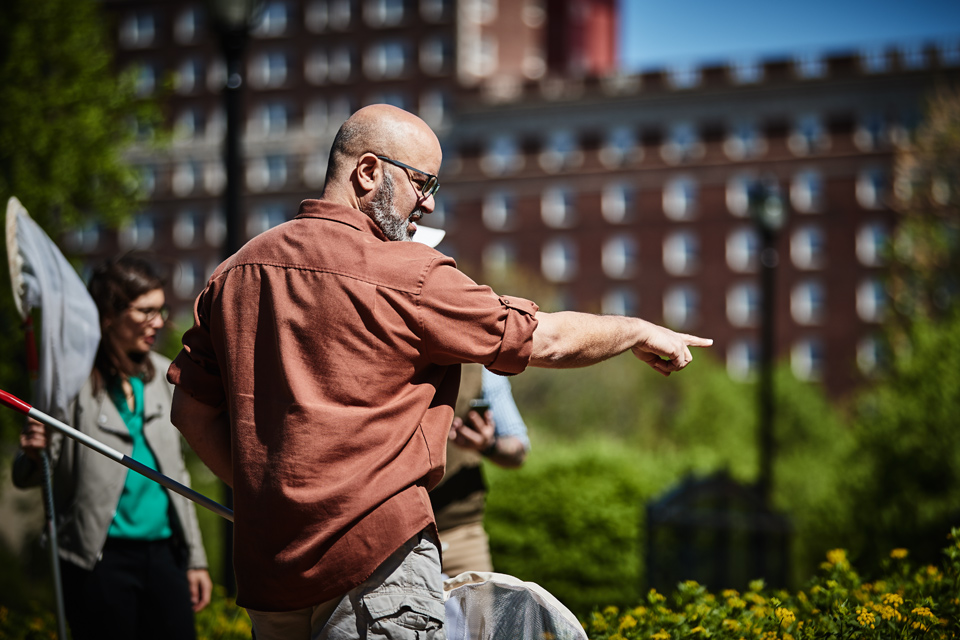
“The worst place to learn science is in a classroom. You learn science by seeing and doing,” Camilo said. “When I take students to the field, I’m taking them so they can see and understand the social, economic and even ethnic dynamics of this food-producing system. Not just the bee part but an entire history.”
His team of researchers — which includes graduate and undergraduate students — learns quickly that they are subject to the impulses of the insects. Of course, bees are out in warmer months, so most collecting happens over the summer.
“In St. Louis, it’s 100 degrees and 90 percent humidity. The moment you get out there, you’re sweating,” he said. “But actually it doesn’t matter how hot it is. Bees care more about how high the sun is in the sky because they don’t see in regular light, they see in ultraviolet. You get a cloudy day, they don’t come out. Rainy day, even less. You’re out in the middle of the day and a big cloud rolls in? They’re done.”
Even at the whim of bees, student researchers seize the opportunity.
Jordyn Riehn (A&S ’19) switched majors at the end of her freshman year from a pre-med focus to biology with a concentration in ecology, education and conservation. She’d planned to nanny during the summer, but Camilo offered her a job in his lab, sampling and assisting graduate students.
“I woke up early and showed up five days a week that whole summer,” Riehn said.
She ended up working in his lab throughout her college career and even got to carry out an independent research project through his lab. Her project — about bees and “green” food roofs, in coordination with the nonprofit Urban Harvest STL — was the first on the topic in St. Louis.
“For me to allow independent research in my lab, it has to be a truly meaningful question,” Camilo said. “It has to be something that advances your education, your career. It has to be a real scientific contribution.”
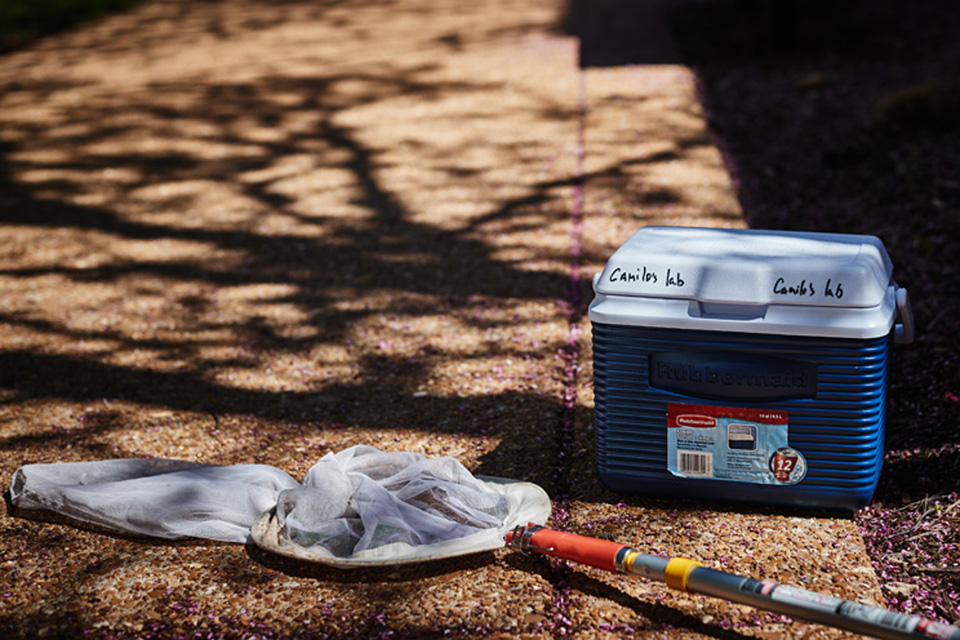
Riehn definitely took it seriously — over two summers, she collected close to 900 bees, about 25 unique species — and her experience was invaluable.
“I’ve actually done something in undergrad beyond just going to class,” she said. “I put on my hiking boots and grabbed my butterfly net, and made it happen. I collected data; I interpreted it. And I learned how to communicate the value of what I was doing, why I was killing something in order to protect it.”
Riehn’s work provided more information about what kinds of bees are found in food roofs — which could lead to a greater understanding of how to encourage bees in urban environments.
Where the Bees Are
Camilo’s specialty is biometry, the application of statistical analysis to biological
data.
“I’m astounded at how quickly he can take something we observed in nature and make
it mathematical,” Riehn said.
Specifically, Camilo is interested in spatial ecology: He studies species in relation to the spaces they occupy. As he collected bees across St. Louis and crunched the numbers, he noticed a striking divide.
“We found that when you go to the north side of the city, you have this tremendous diversity and abundance of bees. When you get to the south side, you lose a lot of that,” Camilo said.
What does the north side of the city have to offer?
For one thing, land — lots of it — with great conditions for bees.
“Most bees are solitary. There’s no queen; it’s a single mother making a hole in the ground. She needs exposed bare ground, and she needs soil that is the proper chemistry,” Camilo said. “Having vacant lots with a lot of exposed soil matters.”
In other parts of the city, that kind of space is harder to find. Community gardens tend to spring up in places where the land isn’t being developed for other things, whether that’s farmland or commercial or residential real estate.
Camilo, who lives near campus in one of the oldest neighborhoods in St. Louis, is critical of the way land tends to be used in this country, including the typical American yard.
“The problem with the way we grow lawns in the United States is that you end up with this very thick mat of essentially rotting vegetation,” he said. “It’s pointless.”
And then, he said, we start to worry about what the neighbors will think.
“We have this aesthetic sensitivity about how the nature around our homes should look, and we’ve codified those sensitivities into neighborhood associations. How high can you keep your lawn? How many trees can you put in your yard, and what kind? The collective set of decisions leads to standardization across the spatial regime,” he said. “We call it homogeneity.”
On a larger scale, Americans also have homogenized the way we farm.
“The way we grow food has changed more in the last 50 years than in the previous 5,000,” Camilo said. “Agricultural policy in the United States favors huge amounts of monoculture so you can then homogenize your product. We have learned to homogenize our crops by homogenizing the environment and homogenizing the genetics of the crops.”
Unfortunately, although homogeneity might produce a lovely landscape or consistent crops, it does not encourage bees or other pollinators. To thrive, most bees need a broad diet — easy access to different kinds of pollen.
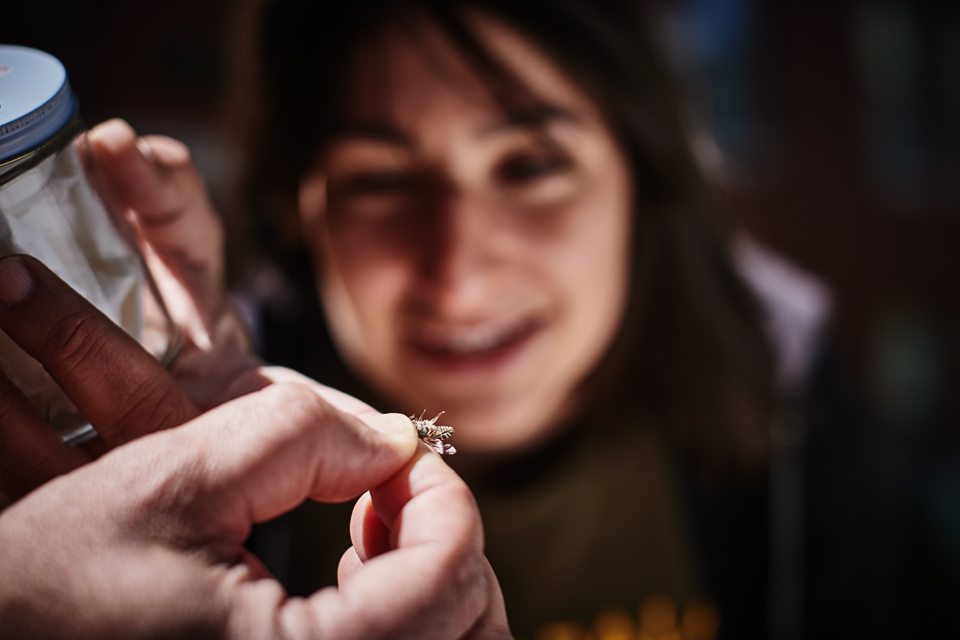
It makes sense, then, that Camilo found so many different kinds of bees in St. Louis’ community gardens — they produce a diverse bounty.
“Especially on the north side, there is a broad range of cultural representation. St. Louis’ International Institute runs several of the gardens, where you have refugees from Sub-Saharan Africa, Saharan Africa, Southeast Asia and Latin America all planting. People tend to grow stuff they like and know how to cook,” Camilo said. “That leads to a diversity of flower resources, which leads to a diversity of bees.”
Busy as a...
Knowing that native bees are thriving in the city’s community gardens and food roofs gave Camilo traction. The next step is mapping pollinators in the area on a greater scale.
Camilo’s lab has partnered with the St. Louis Audubon Society’s Bring Conservation Home program, which helps area property owners restore native plant and animal habitat on their land. The program gave the researchers access to two large data sets: one of homeowners across the area, and another of geographical information about vegetation.
“It’s a symbiotic relationship,” said Trey Hull (Grad PH ’18), a graduate student in Camilo’s lab. “We have the scientific expertise, but not the ability to gather people. The Audubon Society gives us the approachability, and we’ll produce the research.”
Camilo’s research team is only a couple months into this project, which he predicts could last as long as a decade.
“Our big focus is on pollinators, obviously, but it’s an ecosystem; everything supports everything else,” Hull explained. “One of the things I enjoy about being in this lab is we’re looking at it from both sides. If you increase biodiversity, is that helping pollinators? Or conversely, how does the lack of biodiversity affect them?”
Camilo said, “It always comes back to spatial patterning, how it affects issues of diversity. And then how people layer on top of that.”
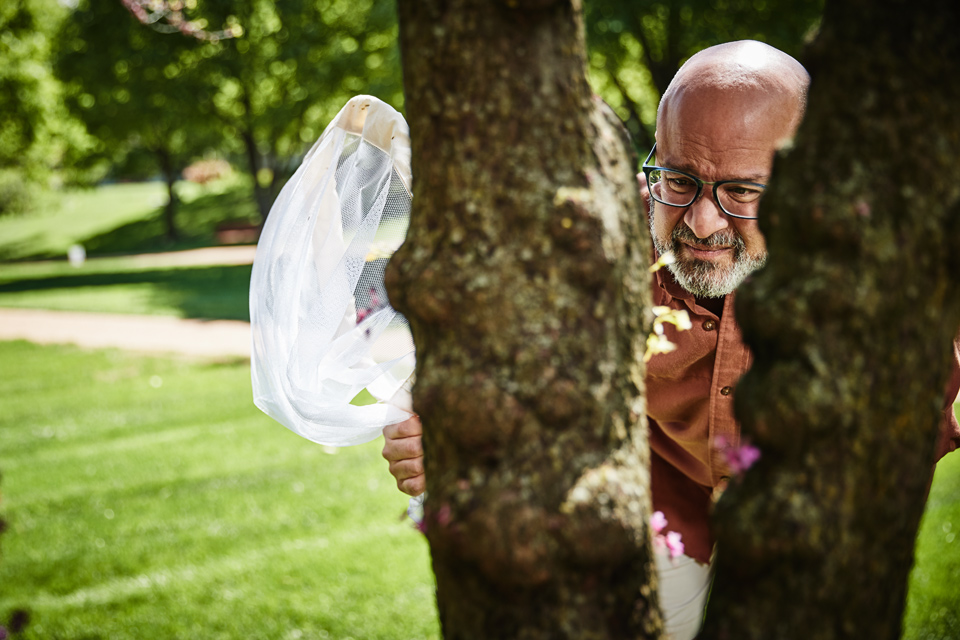
In addition to the broad reach of the Audubon Society project, Camilo also operates at the individual level. He participates in citizen-science projects, teaching lay people to help collect bees.
“Many people are aware of the pollinator crisis and may have a rudimentary idea of the overall impact, but recent research has shown that most people can’t identify most bees, or how this crisis affects them personally,” Camilo said.
He has a bigger goal in mind.
“We need to develop a national pollinator conservation policy,” he said. “Effective policy changes come about as a consequence of knowledge and understanding, and that starts with education.”
After more than two decades educating and researching at Saint Louis University, Camilo has no plans to stop anytime soon. There are more fields to visit, more bees to collect.
Backyard Bees
How can you help save the bees?
“The motto in my lab is ‘help people help bees,’” Camilo said. Here’s his advice for creating a bee-positive environment in your space, whether that’s a small plot in a community garden or a vast suburban yard.
- Plant natives, period.
- Don’t mulch, or mulch a lot less, because bees need exposed, open soil.
- Mow less. Take a break every other weekend. Let it get a little bit wild. Let those native violets and dandelions come out a little bit.
- Be extremely aware of your use of pesticides. Camilo won’t tell you not to use them because there are reasons to, he said. But be careful. Follow the specific directions for usage. Don’t just spray haphazardly.
— By Amy Garland, photos by Douglas Garfield
Founded in 1818, Saint Louis University is one of the nation’s oldest and most prestigious Catholic institutions. Rooted in Jesuit values and its pioneering history as the first university west of the Mississippi River, SLU offers nearly 13,000 students a rigorous, transformative education of the whole person. At the core of the University’s diverse community of scholars is SLU’s service-focused mission, which challenges and prepares students to make the world a better, more just place.


















